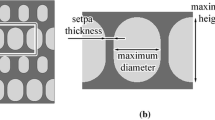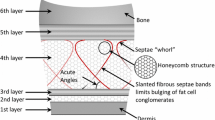Abstract
In diabetic neuropathic subjects, the hardness of foot sole soft tissue increases, and its thickness reduces, in different foot sole areas. Finite element analysis (FEA) of a three-dimensional two-arch model of the foot was performed to evaluate the effect of foot sole stresses on plantar ulcer development. Three sets of foot sole soft-tissue properties, i.e. isotropic (with control hardness value), diabetic isotropic (with higher hardness value) and anisotropic diabetic conditions, were simulated in the push-off phase, with decreasing foot sole soft-tissue thicknesses in the forefoot region, and the corresponding stresses were calculated. The results of the stress analyses for diabetic subject (anisotropic) foot models showed that, with non-uniformly increased hardness and decreased foot sole soft-tissue thickness, the normal and shear stresses at the foot sole increased (compared with control values) by 52.6% and 53.4%, respectively. Stress analyses also showed high ratios of gradients of normal and shear stresses of the order of 6.6 and 3.3 times the control values on the surface of the foot sole, and high relative values of stress gradients for normal and shear stresses of 6.25 and 4.35 times control values, respectively, between the foot sole surface and the adjacent inner layer of the foot sole, around a particular region of the foot sole with anisotropic properties. These ratios of high gradients and relative gradients of stresses due to changes in softtissue properties may be responsible for the development of plantar ulcers in diabetic neuropathic feet.
Similar content being viewed by others
References
Abouaesha, F., Van Schie, C. H. M., Griffiths, G. D., Young, R. J., andBoulton, A. J. M. (2001): ‘Plantar thickness is related to peak plantar pressure in the high-risk diabetic foot’,Diabetes Care,24, pp. 1270–1274
Armstrong, D. G., Lavery, L. A., andBushman, T. D. (1998): ‘Peak foot pressures influence the healing time of diabetic foot ulcers treated with total contact casts’,J. Rehabil. Res. Dev.,35, pp. 1–5
Basmajian, J. V., andDeluca, C. J. (1978): ‘Muscle alive: Their function revealed by electromyography’ (Williams & Wilkins, Baltimore, 1978)
Birke, J. A., Novick, A., Hawkins, E. S., andCharles, P. A. (1995): ‘A review of causes of foot ulcerations in patients with Diabetes Mellitus’,J. Prosthet. Orthot.,14, pp. 13–22
Calderale, P. M., andScelfo, G. (1987): ‘A mathematical model of the locomotor apparatus’,Eng. Med.,16, pp. 147–161
Gefen, A., Megido-Ravid, M., Itzchak, I., andArcan, M. (2000): ‘Biomechanical analysis of 3 D foot structure during gait: A basic tool for clinical application’,J. Biomech. Eng.,122, pp. 614–620
Hayes, W. C., Keer, L. M., Herrmann, G., andMockros, L. F. (1972): ‘A mathematical analysis for indentation tests of articular cartilage’,J. Biomech.,5, pp. 541–551
Hertz, D. L., andFarinella, A. C. (1998): ‘Shore: A durometer and engineering properties’. New York Rubber Group, Technical meeting
Inman, V. T., Raiston, H. J., andTodd, F. (1981): ‘Human walking’ (Williams and Wilkins, Baltimore, 1981)
Jacob, S., andPatil, K. M. (1999): ‘Three dimensional foot modeling and analysis of stresses in normal and early stage of Hansen’s disease with muscle paralysis’,J. Rehabil. Res. Dev.,36, pp. 252–263
Kapandji, A. (1970): ‘The physiology of joints, vol.2- Lower limb’ (E&S Livingstone, London, 1970)
Landsman, A. S., Meaney, D. F., Cargill, R. S., Macarak, E. J., andThibault, L. E. (1995): ‘High strain rate tissue deformation—A theory on the mechanical etiology of diabetic foot ulcerations’,J. Am. Podiatric Med. Assoc.,85, pp. 519–527
McMinn, J., Fogle, J., Byars, E., andWeaver, G. (1989): ‘Effects of embalming on the mechanical properties of beef bone’,J. Appl. Physiol.,19, pp. 1234–1236
Nakamura, S., Crowninshield, R. D., andCooper, R. R. (1981): ‘An analysis of soft tissue loading in the foot—a preliminary report’,Bull. Prosth. Res.,18, pp. 27–34
Patil, K. M., Braak, L. H., andHuson, A. (1996): ‘Analysis of stresses in two-dimensional models of normal and neuropathic feet’,Med. Biol. Eng. Comput., pp. 280–284
Pigassesi, A., Romanelli, M., Schipani, E., Campi, F., Magiliaro, A., Baccetti, F., andNavalesi, R. (1999): ‘Hardness of plantar ulcers in diabetic neuropathic feet’,J. Diabet. Complicat.,13, pp. 129–134
Robertson, D. D., Mueller, M. M., Smith, K. E., Commean, P. K., Pilgram, T., andJohnson, J. E. (2002): ‘Structural changes in the forefoot of individuals with diabetes and prior plantar ulcer’,J. Bone Joint Surg.,84-A, pp. 1395–1404
Rohrle, H., Scholten, R., Sigolotto, C., andSolbach, W. (1984): ‘Joint forces in the human pelvis-leg skeleton during walking’,J. Biomech.,17, pp. 409–424
Schreppers, G. J. M. A., Sauren, A. A. H. J., andHuson, A. (1990): ‘A numerical model of transmission in the tibio-femoral contact area’,Proc. Inst. Mech. Eng. H,204, pp. 53–59.
Seireg, A., andArvikar, R. J. (1975): ‘The prediction of muscular load sharing and joint forces in the lower extremities during walking’,J. Biomech.,8, pp. 89–102
Thompson, D. L., Cao, D., andDavis, B. L. (1999): ‘Effects of diabetic induced soft tissue changes on stress distribution in the calcaneal soft tissue’. Proc. XVII ISB Congress, Calgary, pp. 8–13
Weng-Pin, C., Fuk-Tan, T., andChia-Wei, J. (2001): ‘Stress distribution of foot during mid stance to push off in bare foot gait; A 3-D finite element analysis’,Clin. Biomech.,16, pp. 614–620
Williams, P. L., Warwick, R., Dyson, M., andBannister, L. H. (1989): ‘Gray’s anatomy, 37th edn’ (Churchill and Livingstone, New York, 1989)
Zheng, Y. P., Choi, Y. K. C., Wong, K., andMak, A. F. T. (1999): ‘Indentation assessment of plantar foot tissue in diabetic patients’, Proc. First Joint BMES/EMBS Conf., 13–16 Oct, Atlanta, GA, USA, 634
Author information
Authors and Affiliations
Corresponding author
Rights and permissions
About this article
Cite this article
Thomas, V.J., Patil, K.M. & Radhakrishnan, S. Three-dimensional stress analysis for the mechanics of plantar ulcers in diabetic neuropathy. Med. Biol. Eng. Comput. 42, 230–235 (2004). https://doi.org/10.1007/BF02344636
Received:
Accepted:
Issue Date:
DOI: https://doi.org/10.1007/BF02344636




